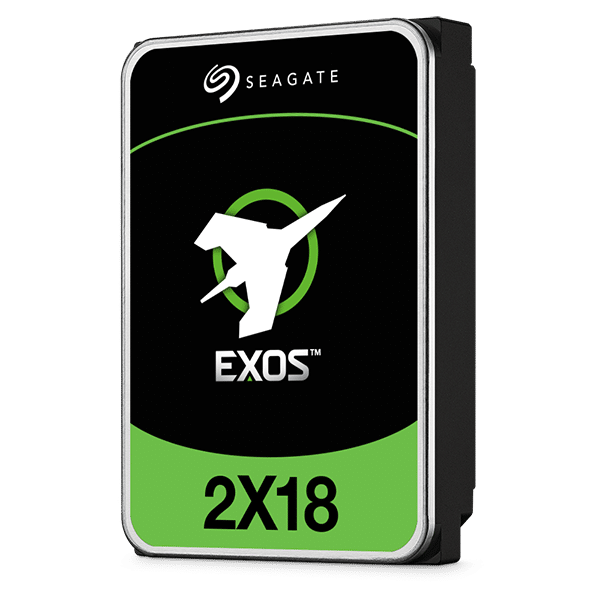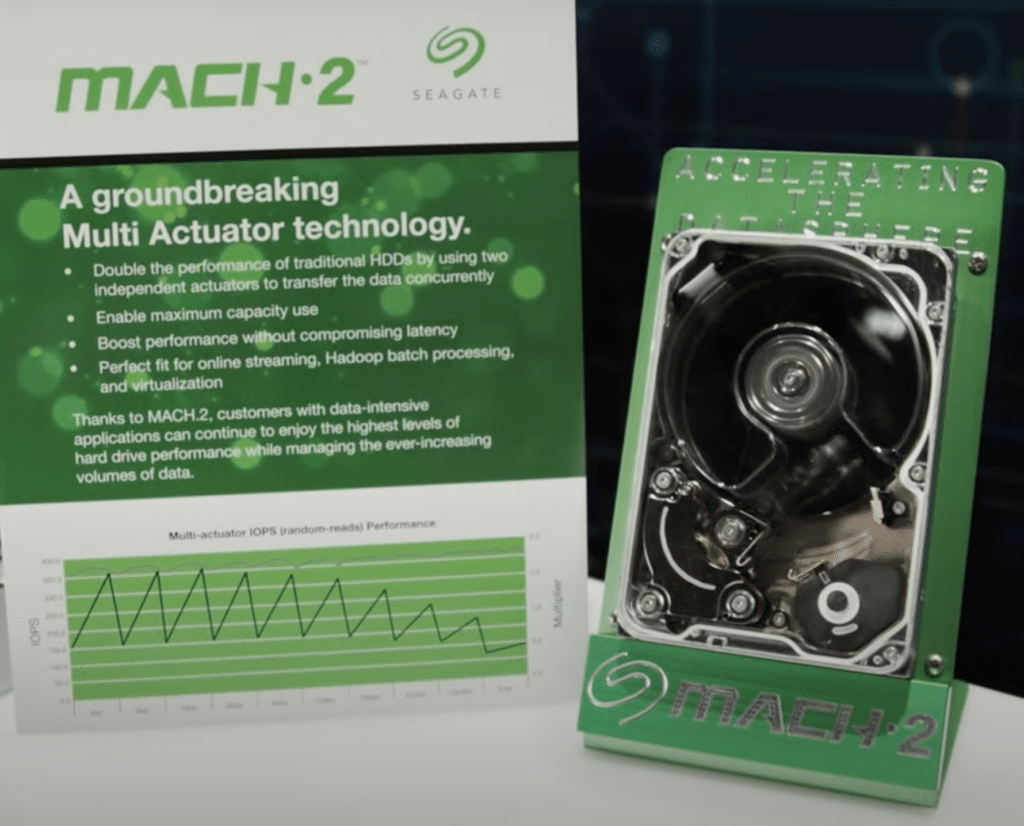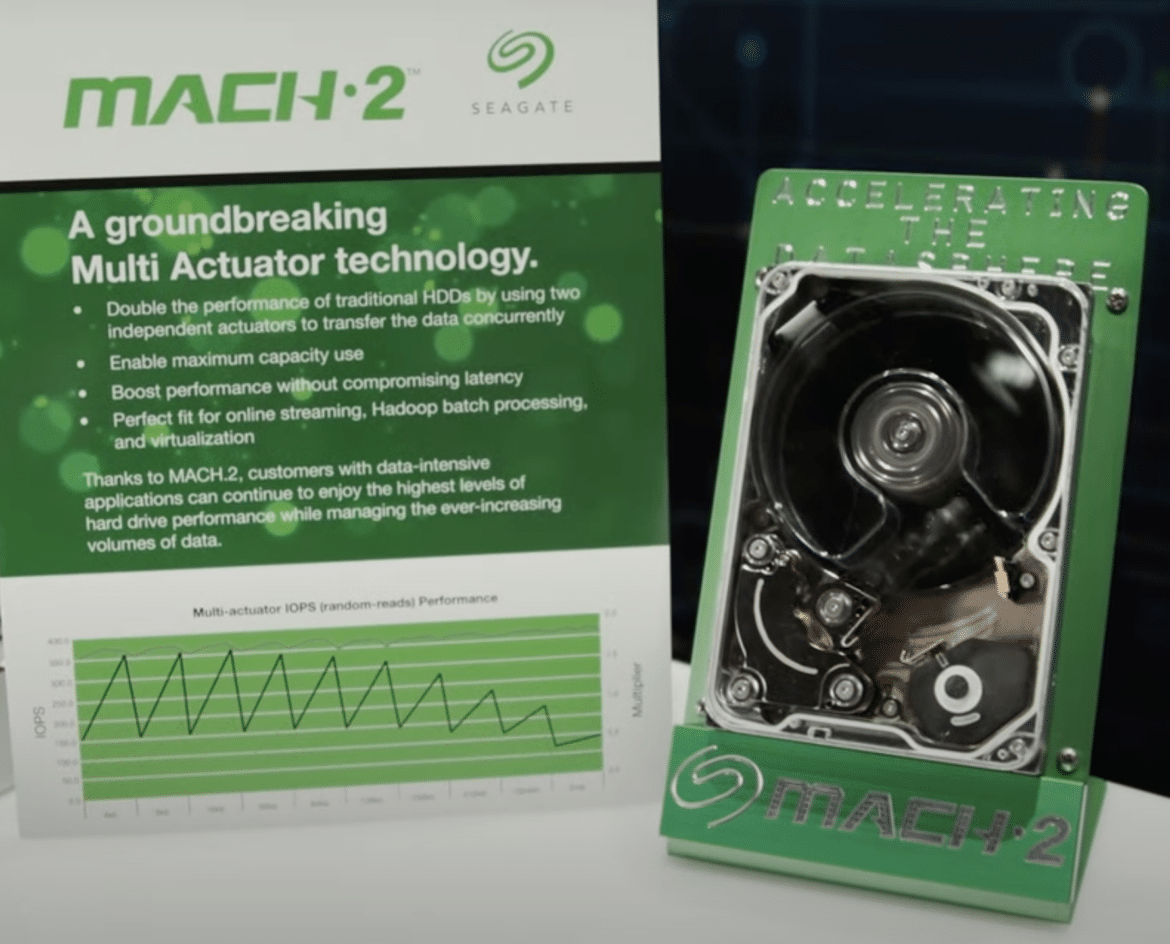Seagate has updated its lineup of dual-actuator hard drives (named MACH.2) with the Seagate Exos 2X18. First shipped in 2019, these HDDs owe their speedy performance to its twin actuators via the MACH.2 technology, quoting up to double the performance of competing enterprise single-actuator 3.5-inch hard drives. This makes them ideal for environments like hyperscale applications, both cloud and massive scale-out data centers, and content delivery networks.
Seagate has updated its lineup of dual-actuator hard drives (named MACH.2) with the Seagate Exos 2X18. First shipped in 2019, these HDDs owe their speedy performance to its twin actuators via the MACH.2 technology, quoting up to double the performance of competing enterprise single-actuator 3.5-inch hard drives. This makes them ideal for environments like hyperscale applications, both cloud and massive scale-out data centers, and content delivery networks.

Seagate MACH.2
MACH.2 is the company’s name for its multi-actuator technology. HDD performance is restricted by the number of actuators (the part of the drive that moves the heads over the media surface), which means that more actuators theoretically translate to faster drives. As such, Seagate indicate can perform up to double the performance of an enterprise single-actuator 3.5-inch hard drive for both random IOPS and sequential data rates.

Multi-actuator is very much a Seagate advantage today. In fact, there’s been much consternation over at WD, as Seagate ran to market with the initial MACH.2 deliveries before WD had perfected their version of the technology. While this gave Seagate an engineering halo, this may have also slowed the adoption of multi-actuator outside of the hyperscalers, where storage providers prefer to have more than one source for key components.
Today the Seagate line is dual-actuator, but it’s reasonable to expect three or even more actuators could be used in future hard drives.
Seagate Exos 2X18 Highlights
The updated dual-actuator hard drive line is available in two capacities (16TB and 18TB) in both 12Gb/s SAS and 6Gb/s SATA interface models. The 18TB model functions as two independently addressable 9TB logical units to the host system, which allows users to increase performance while effectively using the full capacity of the drive.
For performance, the Exos 2X18 12Gb/s models are quoted to deliver 554MB/s read max sustained transfer rates (which is on par with—and sometimes superior to—SATA SSDs) while hitting reads and writes of 304 IOPS and 560 IOPS, respectively, in random 4K performance. This is a tik better performance over the Exos 2X14, which was specced at 524MB/s in sustained transfer rates and 308 IOPS read and 448 IOPS write in 4K performance.
Power consumption is, expectedly, a little higher for Seagate’s new dual-actuator hard drives, ranging from an average of 7.8W to 8W in idle mode. It also features a 2.5 million hour Mean Time Between Failures (MTBF).
Seagate Exos 2X18 Full Specifications
| Specifications | SAS 12Gb/s | SATA 6Gb/s | SAS 12Gb/s | SATA 6Gb/s |
| Capacity | 18TB | 18TB | 16TB | 16TB |
| Standard Model FastFormat (512e/4Kn) | ST18000NM0272 | ST18000NM0092 | ST16000NM0002 | ST16000NM0092 |
| SED Model FastFormat (512e/4Kn) | ST18000NM0012 | — | ST16000NM0012 | — |
| Capacity per Logical Unit | 9TB | — | 8TB | — |
| Capacity per Actuator | 9TB | 9TB | 8TB | 8TB |
| Features | ||||
| Helium Sealed-Drive Design | Yes | Yes | Yes | Yes |
| Protection Information (T10 DIF) | No | No | No | No |
| SuperParity | Yes | Yes | Yes | Yes |
| Low Halogen | Yes | Yes | Yes | Yes |
| PowerChoice Idle Power Technology | Yes | Yes | Yes | Yes |
| PowerBalance Power / Performance Technology | Yes | Yes | Yes | Yes |
| Hot-Plug Support | Yes | Yes | Yes | Yes |
| Cache, Multisegmented (MB) | 256 | 256 | 256 | 256 |
| Organic Solderability Preservative | Yes | Yes | Yes | Yes |
| RSA 2048 Firmware Verification (SD&D) | Yes | Yes | Yes | Yes |
| Reliability/Data Integrity | ||||
| Mean Time Between Failures (MTBF, hours) | 2,500,000 | 2,500,000 | 2,500,000 | 2,500,000 |
| Reliability Rating @ Full 24×7 Operation (AFR) | 0.35% | 0.35% | 0.35% | 0.35% |
| Nonrecoverable Read Errors per Bits Read | 1 sector per 10E15 | 1 sector per 10E15 | 1 sector per 10E15 | 1 sector per 10E15 |
| Power-On Hours per Year (24×7) | 8,760 | 8,760 | 8,760 | 8,760 |
| 512e Sector Size (Bytes per Sector) | 512 | 512 | 512 | 512 |
| 4Kn Sector Size (Bytes per Sector) | 4,096 | 4,096 | 4,096 | 4,096 |
| Limited Warranty (years) | 5 | 5 | 5 | 5 |
| Performance | ||||
| Spindle Speed (RPM) | 7200RPM | 7200RPM | 7200RPM | 7200RPM |
| Interface Access Speed (Gb/s) | 12.0, 6.0, 3.0 | 6.0, 3.0 | 12.0, 6.0, 3.0 | 6.0, 3.0 |
| Max. Sustained Transfer Rate OD (MB/s,MiB/s) | 554 MB/s/528 MiB/s | 545 MB/s/520 MiB/s | 554 MB/s/528 MiB/s | 545 MB/s/520 MiB/s |
| Random Read/Write 4K QD16 (IOPS) | 304/560 | 304/560 | 304/560 | 304/560 |
| Average Latency (ms) | 4.16 | 4.16 | 4.16 | 4.16 |
| Interface Ports | Single | Single | Single | Single |
| Rotation Vibration @ 20-1500 Hz (rad/sec²) | 12.5 | 12.5 | 12.5 | 12.5 |
| Power Consumption | ||||
| Idle A (W) Average | 8W | 7.8W | 8W | 7.8W |
| Random Read/Write 4K/16Q (W) | 11.5 W/9.6 W | 11.1 W/9.2 W | 11.5 W/9.6 W | 11.1 W/9.2 W |
| Sequential Read/Write 256K/16Q (W) | 13.5 W/12.8 W | 13.1 W/12.3 W | 13.5 W/12.8 W | 13.1 W/12.3 W |
| Power Supply Requirements | +12 V and +5 V | +12 V and +5 V | +12 V and +5 V | +12 V and +5 V |
| Environmental | ||||
| Temperature, Operating (°C) | 5°C – 60°C | 5°C – 60°C | 5°C – 60°C | 5°C – 60°C |
| Vibration, Nonoperating:
2 to 500Hz (Grms) |
2.27 | 2.27 | 2.27 | 2.27 |
| Shock, Operating 2ms (Read/Write) (Gs) | 40 | 40 | 40 | 40 |
| Shock, Nonoperating 2ms (GS) | 200 | 200 | 200 | 200 |
| Physical | ||||
| Height (in/mm, max) | 1.028in/26.1mm | 1.028in/26.1mm | 1.028in/26.1mm | 1.028in/26.1mm |
| Width (in/mm, max) | 4.01in/101.85mm | 4.01in/101.85mm | 4.01in/101.85mm | 4.01in/101.85mm |
| Depth (in/mm, max) | 5.787in/147mm | 5.787in/147mm | 5.787in/147mm | 5.787in/147mm |
| Weight (lb/gm) | 1.466lb/665g | 1.466lb/665g | 1.466lb/665g | 1.466lb/665g |
| Carton Unit Quantity | 20 | 20 | 20 | 20 |
| Cartons per Pallet/Cartons per Layer | 40/8 | 40/8 | 40/8 | 40/8 |
Engage with StorageReview
Newsletter | YouTube | Podcast iTunes/Spotify | Instagram | Twitter | TikTok | RSS Feed

